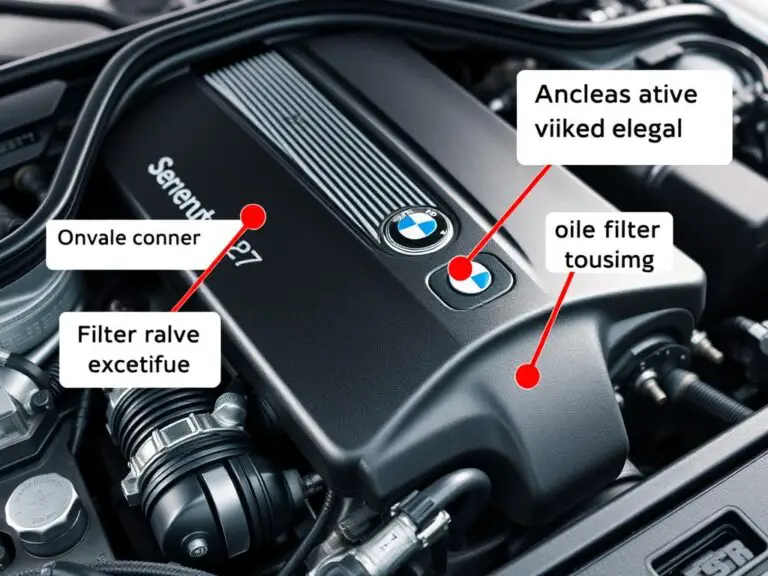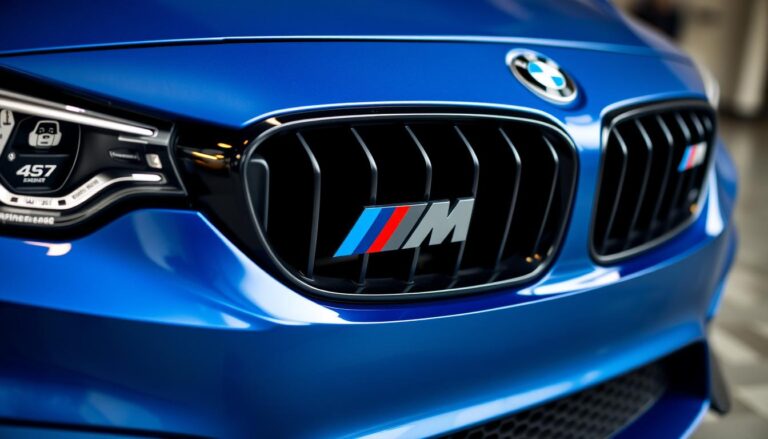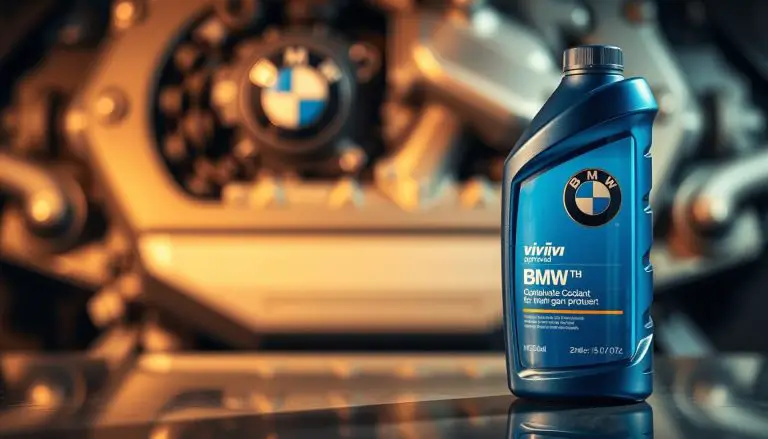The myriad of BMW model numbers and badges can initially perplex. Yet, these symbols convey crucial details about your vehicle’s capabilities, its array of features, and its historical lineage.
The BMW naming convention is a sophisticated framework that unveils the essence of your automobile. It discloses the model, the engine’s configuration, and other pivotal attributes. By unraveling these enigmas, you can attain a profound comprehension of your vehicle’s specifications and its distinction from other BMW models.
Unraveling the enigma of your BMW‘s model numbers and badges is an invaluable pursuit for any aficionado or proprietor. This discourse aims to elucidate the importance of these identifiers and furnish a detailed manual for grasping your vehicle’s singular attributes.
Key Takeaways
- Understand the significance of BMW model numbers and badges
- Learn how to decipher the BMW naming convention
- Discover how to identify your vehicle’s unique characteristics
- Gain insight into your car’s specifications and features
- Enhance your knowledge of BMW models and their differences
The Evolution of BMW Model Numbers and Badges
BMW’s model numbering and badging system has undergone significant transformations since its inception. The company’s approach to naming its vehicles has evolved considerably over the years, influenced by technological advancements, market trends, and the company’s strategic goals.

Early Naming Conventions (1923-1980)
In the early years, BMW’s naming conventions were relatively straightforward, often reflecting the company’s focus on aircraft engines and motorcycles. The first cars produced by BMW were designated with internal project codes, and it wasn’t until later that a more systematic approach was adopted. During this period, BMW used a combination of letters and numbers to identify different models, laying the groundwork for the more complex system that followed.
Transition to Modern Nomenclature (1980-2000)
The 1980s marked a significant turning point for BMW, as the company began to adopt a more modern and systematic approach to model naming. This period saw the introduction of the 3 Series, 5 Series, and 7 Series designations, which have since become iconic in the automotive world. These changes reflected BMW’s growing focus on the luxury and performance segments, as well as its efforts to create a more coherent brand identity.
The Philosophy Behind the System
The philosophy behind BMW’s model numbering and badging system is rooted in a desire to convey performance, luxury, and innovation. The use of specific numbers and letters is designed to communicate the unique characteristics of each model, from engine size and type to drivetrain configuration and performance capabilities. This system allows BMW to efficiently differentiate between its various models and trim levels, providing customers with a clear understanding of what to expect from each vehicle.
Decoding the Series: From 1 to 8
The BMW series spans a vast array of vehicles, commencing with the entry-level 1 and 2 Series and culminating in the esteemed 7 and 8 Series. This expansive range enables BMW to cater to a diverse clientele, from novice luxury car buyers to seasoned aficionados in pursuit of high-performance vehicles.

Entry-Level Series: 1 and 2
The 1 and 2 Series serve as BMW’s gateway to the luxury vehicle market. These models are crafted to deliver a superior driving experience, mitigating the financial burden typically associated with larger models.
Hatchbacks, Coupes, and Gran Coupes
The 1 Series is available in a variety of body styles, including hatchbacks and coupes, catering to diverse preferences. In contrast, the 2 Series is distinguished by its coupe and convertible variants, underscoring sportiness and aesthetic appeal.
Core Models: 3 and 5 Series
The 3 and 5 Series form the core of BMW’s lineup, striking a harmonious balance between performance, luxury, and technological advancements. These models are celebrated for their driving dynamics, serving as benchmarks within their respective segments.
The Backbone of BMW’s Lineup
The 3 Series is acclaimed for its agility and responsiveness, earning it a special place among driving enthusiasts. The 5 Series, conversely, offers a more expansive interior, making it an ideal choice for both executives and families.
Luxury Flagships: 7 and 8 Series
The 7 and 8 Series embody the zenith of BMW’s luxury offerings. Equipped with cutting-edge technology, premium materials, and potent engines, these models cater to those who aspire to the pinnacle of luxury and performance.
Prestige and Technology Showcases
The 7 Series is celebrated for its unparalleled comfort and opulence, often positioning itself as a rival to other luxury sedans. The 8 Series, with its sleek design and robust performance, stands as a testament to exclusivity and driving exhilaration.
Understanding BMW Model Numbers and Badges in Detail
The intricacies of BMW’s model numbers and badges unveil a wealth of information regarding the vehicle’s engine, drivetrain, and performance capabilities. To fully appreciate the complexity of BMW’s lineup, it is imperative to comprehend the components that comprise a BMW’s model designation.
Engine Size and Performance Indicators
BMW’s model numbers frequently include indicators of engine size and type. For instance, a BMW 320i typically signifies a 2.0-liter turbocharged inline-four engine. Grasping these indicators is crucial for identifying the performance capabilities of a BMW.
From Actual to Nominal Displacement
Historically, BMW model numbers were directly correlated with engine displacement. Yet, modern nomenclature employs a more nominal approach, where the model number represents a broader category rather than exact engine size. For example, the BMW 330i might have a 2.0-liter engine, not a 3.0-liter one.
Drivetrain Designations: sDrive vs xDrive
BMW employs specific badging to denote the drivetrain configuration. sDrive refers to rear-wheel drive (RWD), while xDrive signifies all-wheel drive (AWD). The choice between sDrive and xDrive impacts the vehicle’s performance, traction, and overall driving experience.
- sDrive: Rear-wheel drive, typically associated with a more traditional driving feel.
- xDrive: All-wheel drive, enhancing traction and stability, specially in adverse weather conditions.
Special Performance Badges: M, M Sport, and M Performance
BMW’s performance-oriented models are denoted by various ‘M’ badges. Understanding the hierarchy of these badges is essential for appreciating the level of performance and exclusivity.
The Hierarchy of Performance
The ‘M’ division is BMW’s performance arm, with different badges signifying varying levels of performance enhancement.
- M Sport: Cosmetic and some handling upgrades, giving the vehicle a sportier appearance and feel.
- M Performance: Significant performance upgrades, often including engine tuning and aerodynamic enhancements.
- M: The pinnacle of BMW performance, with extensive modifications for maximum power and handling.
By understanding these badges, buyers can make informed decisions about their BMW purchase, balancing performance aspirations with practical considerations.
The X Factor: BMW’s SUV Lineup Explained
BMW’s entry into the SUV market is distinguished by its X models, epitomizing premium quality and superior driving dynamics. The X series has undergone significant expansion, presenting a spectrum of SUVs tailored to diverse market segments and consumer preferences.
X Models and Their Positioning
The BMW X models are crafted to harmonize performance, luxury, and versatility. Spanning from the compact X1 to the expansive X7, each variant is meticulously positioned to fulfill distinct customer requirements.
From X1 to X7: Size and Market Segments
- X1: Compact luxury SUV
- X2/X3/X4: Mid-size SUVs with varying degrees of coupé styling
- X5/X6: Mid-size to large SUVs, with the X6 offering a coupé-style variant
- X7: Full-size luxury SUV
This extensive range enables BMW to address a broad spectrum of market segments, from the more accessible compact SUVs to the opulent full-size SUVs.
Coupe-Styled SUVs: The X Even Numbers
BMW’s even-numbered X models, such as the X2, X4, and X6, are characterized by their coupé-style design, presenting a sportier alternative to conventional SUVs. These models cater to those seeking a fusion of style, performance, and practicality.
Performance SUVs: X M Models
The X M models embody BMW’s high-performance SUV lineup. Engineered by BMW’s M division, they offer enhanced performance, distinctive styling, and premium features. These models are crafted for driving enthusiasts who seek unparalleled performance from their SUVs.
In summary, BMW’s X models present a diverse array of SUVs, addressing various customer needs from compact luxury SUVs to high-performance variants. The strategic positioning of these models reflects BMW’s dedication to innovation and customer satisfaction within the SUV market.
Electric Revolution: BMW i Models and Electrified Badges
The automotive sector is undergoing a paradigm shift towards electric mobility, with BMW’s i sub-brand at the forefront. This transition is not merely a fleeting trend but a profound transformation within the industry.
The i Sub-Brand: i3, i4, i7, and iX
BMW’s i sub-brand has introduced several groundbreaking models, including the i3, i4, i7, and iX. These models embody BMW’s dedication to innovation and sustainability. The i3, for instance, is distinguished by its unique design and the use of sustainable materials. In contrast, the i4 combines electric performance with the practicality of a Gran Coupe.
The i7 and iX further expand BMW’s electric lineup, offering luxury and technological advancements. The i7 exemplifies BMW’s capability to merge electric mobility with luxury, while the iX represents a pioneering SUV that embodies the brand’s vision for the future.
Hybrid Designations: e, iPerformance, and xDrive45e
BMW has introduced various hybrid designations to cater to a broader audience. The e designation is used for plug-in hybrid models, indicating a blend of electric and conventional powertrains. iPerformance models combine the efficiency of electric driving with the performance of BMW’s renowned engines.
The xDrive45e designation signifies a specific level of electrification and performance in BMW’s xDrive lineup, highlighting the brand’s commitment to versatile and efficient drivetrains.
Future Electric Naming Conventions
As BMW continues to expand its electric lineup, the naming conventions for these models will likely evolve. The future may see more streamlined designations or new badges that reflect the brand’s growing electric portfolio.
The Vision for Electrified BMW Badging
BMW’s vision for electrified badging involves creating a clear and consistent identity for its electric and hybrid models. This includes distinguishing between purely electric models and those that are part of the hybrid lineup, ensuring that customers can easily understand the offerings.
Case Study: Tracking the 3 Series Evolution Through Badges
The BMW 3 Series’ history is a complex tapestry of technological progress and shifting market strategies, as evidenced by its badges and model numbers. This model has been a cornerstone of BMW’s lineup, celebrated for its performance, handling, and innovative features.
From E21 to G20: Internal Codes Explained
BMW has employed internal codes to distinguish various 3 Series generations. Beginning with the E21 in 1975, each generation has been assigned a unique code: E30, E36, E46, E90, F30, and most recently, G20. These codes transcend mere identifiers, embodying significant updates in design, technology, and performance.
The transition from one generation to the next has often been marked by substantial changes in the model’s designation and badging. For instance, the shift from the E30 to the E36 introduced new engine options and aerodynamic enhancements.
Model Designation Changes Over Generations
Model designations such as 318i, 325i, and later 328i, 330i, have indicated the engine size and type. Over time, these designations have evolved to reflect changes in engine technology and performance capabilities.
318i to 330e: What Changed and Why
The transition from traditional petrol engines to more efficient and environmentally friendly options is evident in the change from 318i to 330e. The 330e, for example, represents a plug-in hybrid variant, showcasing BMW’s move towards electrification.
| Generation | Internal Code | Notable Features |
|---|---|---|
| 1st | E21 | Introduction of the 3 Series |
| 2nd | E30 | Improved performance, new engine options |
| 5th | E90 | Advanced technology, including iDrive |
| 6th | F30 | More efficient engines, updated design |
| 7th | G20 | Modern design, advanced safety features |
What the Badges Reveal About Market Strategy
The badges on the BMW 3 Series not only indicate the model’s specifications but also reflect BMW’s market strategy. The introduction of badges like xDrive and M Sport signifies the importance of all-wheel drive and performance variants in appealing to a broader market.
The use of specific badges and model designations has allowed BMW to target different segments within the market, from the more environmentally conscious consumers to performance enthusiasts.
Regional Variations in BMW Badging
BMW’s adaptation to local market conditions and regulatory requirements manifests as regional variations in badging. These adaptations result in distinct designations and badges across different regions.
North American Market Specifics
The North American market exhibits its own set of BMW badging conventions. Specific models are distinguished with unique badges, differing from those found in other regions.
Unique Models and Badge Differences
Exclusive to the North American market, certain models feature unique badging. This includes specific trim levels or special editions, tailored to meet local consumer preferences.
European vs. American Designation Differences
BMW’s badging conventions in Europe diverge significantly from those in North America. These discrepancies are influenced by local market conditions, regulatory mandates, and consumer preferences.
Gray Market and Import Considerations
Gray market BMWs, imported outside official channels, often display different badging than their officially imported counterparts. This can engender confusion among consumers, necessitating meticulous consideration when making a purchase.
| Model | North American Badging | European Badging |
|---|---|---|
| BMW 3 Series | 328i, 330i, M340i | 318i, 320i, 330i, M3 |
| BMW X5 | xDrive40i, xDrive50i, X5 M | xDrive30d, xDrive40i, X5 M |
BMW vs Competitors: Comparative Badge Analysis
The evolution of the automotive industry necessitates a comparative examination of BMW’s badge strategy against its competitors. This analysis offers profound insights into the luxury car market’s naming conventions.
The luxury automotive segment is characterized by intense competition, with BMW engaging in a battle of prestige against brands such as Mercedes-Benz and Audi. An exploration into how these brands approach their naming and badging unveils broader industry trends.
German Rivals: Mercedes-Benz and Audi Naming Systems
Mercedes-Benz and Audi, akin to BMW, employ intricate naming conventions. Mercedes-Benz utilizes a combination of letters and numbers, exemplified by “C-Class” and “S-Class,” to differentiate models. The inclusion of “AMG” signifies high-performance variants. Audi, in a similar vein, employs numbers like “A4” and “Q7” to denote models, with “S” and “RS” badges indicating sportier versions.
Global Luxury Competitors
Extending beyond German rivals, global luxury competitors such as Lexus and Jaguar have developed unique naming strategies. Lexus employs a combination of letters and numbers (e.g., “IS” and “RX”), while Jaguar utilizes a mix of letters and numbers (e.g., “XE” and “F-Pace”). These naming conventions not only reflect the models’ characteristics but also contribute to the brands’ identities.
Consistency and Brand Recognition Benefits
A consistent naming convention across models and brands enhances brand recognition, simplifying the luxury car market for consumers. BMW’s competitors have also recognized the significance of consistency, often revising their naming strategies to improve clarity and brand cohesion.
An examination of these naming conventions reveals a competitive yet shared understanding of the necessity for clarity and consistency in communicating a brand’s value and identity.
Conclusion: The Future of BMW’s Naming Convention
BMW’s trajectory in innovation and expansion will undoubtedly influence its naming conventions. The advent of electric vehicles is expected to elevate the i sub-brand’s significance, potentially introducing novel designations that underscore BMW’s dedication to eco-friendliness and performance. This development could redefine the brand’s naming strategy, aligning with its commitment to sustainability and technological prowess.
The burgeoning complexity of BMW’s model range may prompt a reevaluation of its naming and badging systems. A more streamlined approach could emerge, balancing simplicity with the retention of informative value. As the automotive sector undergoes continuous transformation, BMW’s naming conventions will evolve to mirror shifting consumer tastes and technological progress. This adaptability will be crucial in maintaining the brand’s relevance amidst a rapidly evolving market.
For enthusiasts and consumers, grasping the nuances of BMW’s current naming system is essential. Staying abreast of BMW’s innovations and automotive trends will enable a deeper understanding of the brand’s offerings. This knowledge will also facilitate anticipation of future developments from this renowned German automaker.
FAQ
What do BMW model numbers represent?
BMW model numbers serve as a numerical identifier, encapsulating the vehicle’s series and engine configuration. This numerical sequence offers a glimpse into the car’s performance attributes and its array of features.
What is the difference between sDrive and xDrive in BMW models?
The distinction between sDrive and xDrive lies in their respective drivetrain configurations. sDrive signifies rear-wheel drive, whereas xDrive denotes all-wheel drive. The latter is designed to enhance traction and stability across a spectrum of driving environments.
What do the M, M Sport, and M Performance badges signify?
The M badge is emblematic of BMW’s high-performance models, crafted by the M division. In contrast, the M Sport and M Performance badges signify a sportier aesthetic and performance enhancements, respectively.
How do BMW’s X models differ from other SUVs?
BMW’s X models, encompassing the X1, X3, and X5, represent a diverse array of SUVs, varying in size and capability. These vehicles offer a plethora of features, including coupe-styled designs and high-performance variants.
What is the significance of BMW’s i sub-brand?
BMW’s i sub-brand symbolizes the brand’s commitment to electric and hybrid vehicles. Models such as the i3, i4, and iX exemplify BMW’s dedication to sustainability and electrification.
How do regional variations affect BMW badging?
Regional variations can lead to distinct BMW badging, manifesting as unique models and badge designations. These differences are influenced by market demand and regulatory requirements.
How does BMW’s naming convention compare to its competitors?
BMW’s naming convention diverges from its competitors, such as Mercedes-Benz and Audi, yet shares commonalities in the use of alphanumeric designations to convey model information.
What can be inferred from the evolution of BMW’s 3 Series badges?
The evolution of the 3 Series badges reveals shifts in BMW’s market strategy, encompassing changes in performance, technology, and design. These transformations reflect the brand’s adaptability to evolving consumer preferences.
What is the future of BMW’s naming convention?
The future of BMW’s naming convention is anticipated to be shaped by trends in electrification, model proliferation, and brand identity. This may lead to innovations in badge designations and model nomenclature.


